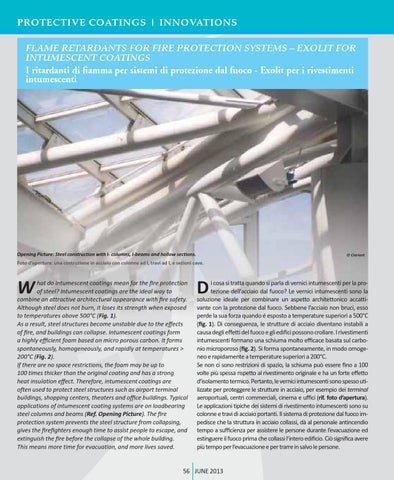PROTECTIVE COATINGS
INNOVATIONS
FLAME RETARDANTS FOR FIRE PROTECTION SYSTEMS – EXOLIT FOR INTUMESCENT COATINGS I ritardanti di fiamma per sistemi di protezione dal fuoco - Exolit per i rivestimenti intumescenti
Opening Picture: Steel construction with I- columns, I-beams and hollow sections.
© Clariant
Foto d’apertura: una costruzione in acciaio con colonne ad I, travi ad I, e sezioni cave.
W
hat do intumescent coatings mean for the fire protection of steel? Intumescent coatings are the ideal way to combine an attractive architectural appearance with fire safety. Although steel does not burn, it loses its strength when exposed to temperatures above 500°C (Fig. 1). As a result, steel structures become unstable due to the effects of fire, and buildings can collapse. Intumescent coatings form a highly efficient foam based on micro porous carbon. It forms spontaneously, homogeneously, and rapidly at temperatures > 200°C (Fig. 2). If there are no space restrictions, the foam may be up to 100 times thicker than the original coating and has a strong heat insulation effect. Therefore, intumescent coatings are often used to protect steel structures such as airport terminal buildings, shopping centers, theaters and office buildings. Typical applications of intumescent coating systems are on loadbearing steel columns and beams (Ref. Opening Picture). The fire protection system prevents the steel structure from collapsing, gives the firefighters enough time to assist people to escape, and extinguish the fire before the collapse of the whole building. This means more time for evacuation, and more lives saved.
D
i cosa si tratta quando si parla di vernici intumescenti per la protezione dell’acciaio dal fuoco? Le vernici intumescenti sono la soluzione ideale per combinare un aspetto architettonico accattivante con la protezione dal fuoco. Sebbene l’acciaio non bruci, esso perde la sua forza quando é esposto a temperature superiori a 500°C (fig. 1). Di conseguenza, le strutture di acciaio diventano instabili a causa degli effetti del fuoco e gli edifici possono crollare. I rivestimenti intumescenti formano una schiuma molto efficace basata sul carbonio microporoso (fig. 2). Si forma spontaneamente, in modo omogeneo e rapidamente a temperature superiori a 200°C. Se non ci sono restrizioni di spazio, la schiuma può essere fino a 100 volte più spessa rispetto al rivestimento originale e ha un forte effetto d’isolamento termico. Pertanto, le vernici intumescenti sono spesso utilizzate per proteggere le strutture in acciaio, per esempio dei terminal aeroportuali, centri commerciali, cinema e uffici (rif. foto d’apertura). Le applicazioni tipiche dei sistemi di rivestimento intumescenti sono su colonne e travi di acciaio portanti. Il sistema di protezione dal fuoco impedisce che la struttura in acciaio collassi, dà al personale antincendio tempo a sufficienza per assistere le persone durante l’evacuazione ed estinguere il fuoco prima che collassi l’intero edificio. Ciò significa avere più tempo per l’evacuazione e per trarre in salvo le persone.
56 JUNE 2013
